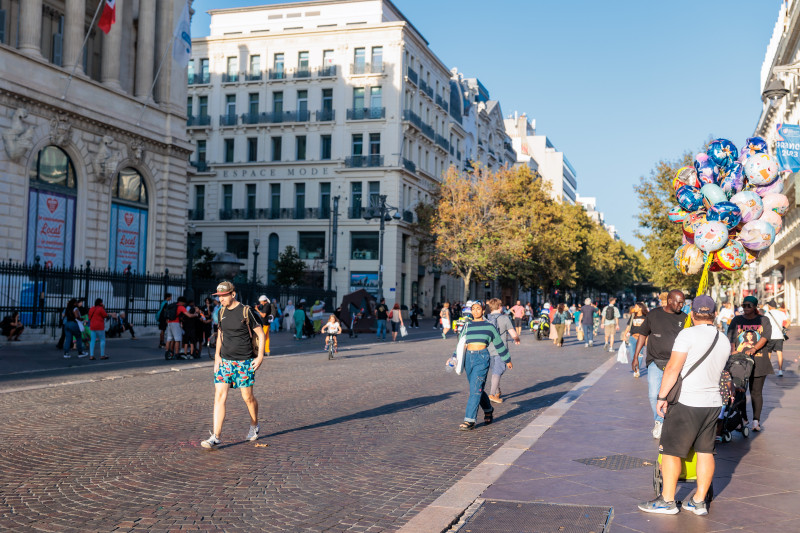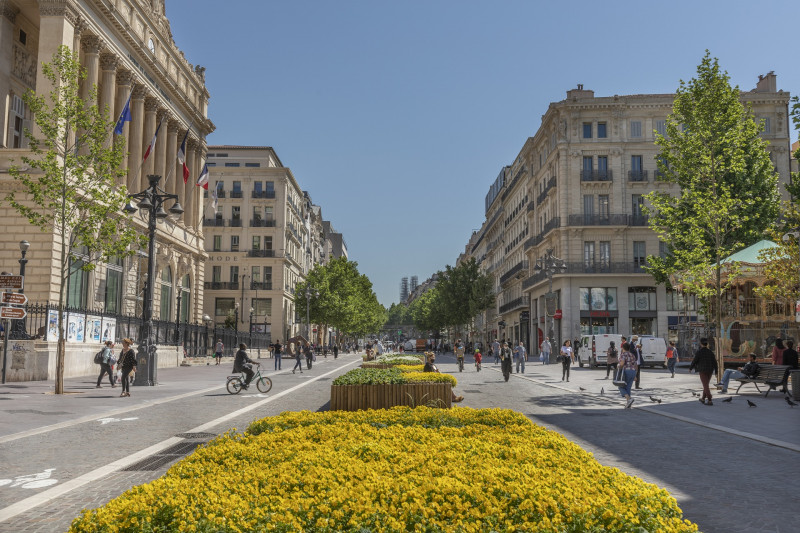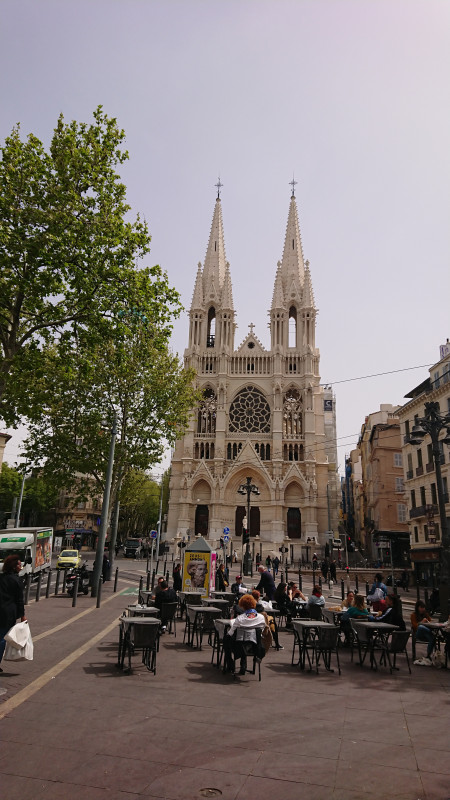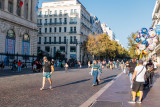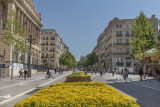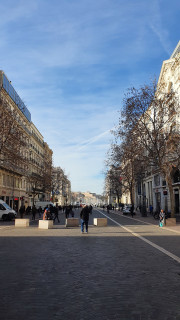La Canebière
Historic site and monumentPresentation
The Canebière was built in 1666 when Louis XIV gave instructions for the city to be increased in size. The name comes from the Provençal "Canebe" (hemp) and is a reminder of the rope-makers that lived in Marseille from the Middles Ages onwards.
Only when the Grand Arsenal (shipbuilding dock) was demolished at the end of the 18th Century was the Canebière extended down to the port and fine buildings put up. A little further on was the narrow Noailles street and beyond it, outside the walls, lay the Allées de Meilhan that provided the people of Marseille with a tree-lined walk that took them past open-air cafés and dance-halls.
The Canebière was only officially extended from the Old Port to the Réformés church in 1928, thus including Noailles street and the allées de Meilhan.
The Second Empire (1852-1870) and colonial expansion were responsible for major changes in the city: new thoroughfares were opened, elegant buildings were constructed and a new port built. The Canebière enjoyed its heyday during the Third Republic (1871-1940) when intense intellectual and business activity was omnipresent in the cafés, high-class hotels and shops. The Canebière became known throughout the world and was very quickly adopted as the symbol of Marseille and its port. Certain buildings are now classified as National Heritage Sites.
The larger hotels and cafés on the Canebière closed after the French colonies gained their independence. The Canebière has recently become central to a number of long-term rehabilitation projects for the city centre and is to some extent reliving its past glory with the marseillais, as the town's inhabitants are known, enthusiastically opening new hotels and shops.
The turkish cafe
One of the first cafés set up on the Canebière is the café alla turca, from 1850 an inevitable passage for travellers to the Orient.
An oriental lounge openend onto to the street Prince de Beauvau.
A monumental fountain, topped by a four-faced clock, sat imposingly in the centre of the main hall, that gave onto the Canebière. It symbolized the open relationship of Marseille with other cultures and showed the Turkish, Chinese, Arabic and European time.
Its sumptuous décor and its atmosphere were often evoked in literature.
The café alla turca disappeaed just after the first world war.
The Beauvau street, which bears the name of a governor of Provence, was opened in 1785 on the land of the Arsenal des Galères (galley arsenal). It was one of the first streets of Marseille made with pavements. Please note Hôtel Beauvau at no. 4 where Lamartine stayed in 1832 as well as Georges Sand and Frédéric Chopin in 1835.
The Opera House
The inhabitants of Marseille have always been theatre and opera fans. Several theatres were in fact built in various parts of the city to meet this local demand. But they had to wait for the sale of the land of the Arsenal des Galères in 1781 to allow the construction of the Grand Théâtre (one of the clauses of the bill of sale stipulated the obligation to construct an opera on the principle of perpetuity). The whole of the land was sold by the Ministère de la Marine to the city who sold it three years later to a company run by Rapalli from Genoa. He started constructing blocks of flats which resulted in extraordinary price explosions. The whole quarter is then organized around this vast plot of land and the streets are dedicated to theatre and music (Corneille, Molière, Lulli, etc) as well as to the high representatives of royalty in Provence.
The Grand Théâtre, opened in 1787, was the work of the architect Benard. He designed it in a neo-classical style as a temple of music and dance. In 1919, a fire completely destroyed the theatre and the stage only the main walls, the Ionic colonnade and the main front in freestone were saved.
The arcitect Gaston Castel, associated with Raymond Ebrard, was chosen to rebuild the Opera from 1921 to 1924 in art deco style. It was the idea of Castel to open this building site to a large number of creative artists and technicians of all areas : painting, sculpture, mosaic and wrought iron.
On the front can be seen the four allegories of Sartorius as well as the phrase written on the upper cornice : « Art receives beauty from Aphrodite, rhythm from Apollo, balance from Pallas and owes movement and life to Dionysos ».
Inside, in the theatre, please note the stage setting « La naissance de la Beauté » by Antoine Bourdelle, in red stucco on a gold background in the main foyer, two superb Sèvres vases especially designed for this vast space and the ceiling decoration by Carrera illustrating the myth of Orpheus and Eurydice in bright colours.
The originality of the building lies in the successful mixture of 18th century neo-classical style and 20th century art deco style.
Hôtel du Louvre et de la Paix.
One of the finest realizations is without doubt the former Hotel du Louvre et de la Paix of the architect Pot, today occupied by the C&A store. The front offers a monumental entrance to visitors framed by four opulent caryatids representing the four continents (Europe, Asia, America and Africa). This luxury category hotel had 250 rooms, 20 salons and 2 restaurant rooms. It was open until 1941, when it was requisitioned and bought by the French Navy, then occupied by the German Kriegsmarine. After the war, the Navy returned, installed offices and used the reception rooms for official events and the officer s mess up to 1977. The decoration had remained the same since the Second Empire.
In 1980, after 3 years of neglect and damage, the building was sold. The architects only kept the fronts, the stairs and and the two salons which were listed as historic buildings. In 1984, the C&A store opened. Inside, on the left, the stairs can still be seen and at the back of the store ordinary doors hide these two magnificents salons, representing the luxurious era of the Hôtel du Louvre et de la Paix.
Projects are currently being studied to try to restore and give new life to this place, a symbol of the commercial power of Marseille in the 19th century. As indicated by a plaque on the front, the first film show of the Lumière brothers in Marseille, "the arrival at La Ciotat railway station", took place in this hotel in 1896.
L’hôtel de Noailles.
It was designed by the architect Berengier in 1865. This very fine building, much more sober than the Hotel du Louvre et de la Paix, has a central front topped by a triangular pediment. The front shows an alternate rhythm of triangular and curved pediments. It used to be a very luxurious hotel and until 1979, very important persons, artists or politicians, stayed at the Noailles.
All hotels of Rue Noailles were so famous that a special daily column was dedicated to them in the newspaper. Today the Noailles building has been transformed into office premises, but it still remains a prestige address.
Les allées de Meilhan.
The Allées de Meilhan are the last part of our Canebière. The expansion of 1666 planned to create a public esplanade outside the city walls. This work was only finished in 1775 thanks to the Provence Intendant, Sénac de Meilhan. This avenue was famous for its open-air cafés where young people came to enjoy themselves and to dance. The style of the buildings is very different from La Canebière and Rue Noailles most of them are from the end of the 18th century. Here the Marseille "three-window" type can be found, like on Boulevard Longchamp further along.
Every year between 1886 and 2005, the " santons fair " takes place on this part of La Canebière. Since 2005, the " santons fair " is based on the Cours d'Estienne d'Orves.
The music pavilion.
The iron music pavilion replaced a older wooden pavilion in 1911. A Wallace fountain, which can also be found in the Parc Longchamp, was installed here in the 1930s.
The monument aux Mobilisés.
The Monument aux Mobilisés was erected here in 1894 to commemorate the soldiers of Marseille who fell in the 1870 war. You can see "France Armée" and at her feet the valiant soldiers. The Monument aux Mobilisés is the departure point for demonstrations which go down La Canebière towards the Old Port, and then often continue towards the Town Hall or the Prefecture according to the nature of the grievances! But here processions also start, for 14 July or for the carnival when the heros of the day proudly rejoice on La Canebière, applauded by the crowd which is always ready to celebrate.
Saint Paul-Saint Vincent church, The Réformés
In the 14th century, the hermits of Saint Augustinian established themselves on the site of the Saint Ferréol church, situated on the Old Port. In the 16th century, their cult was reorganized and the Augustinians Déchaux built another monastery above La Canebière. During the Revolution, the monks were dispersed. In 1803, a new parish was created in this quarter because of its increasing population. A priest of the Mission, a congregation founded in 1625 by Saint Vincent de Paul became the first priest of this quarter. The construction of the new church in a neo-gothic style followed the plan of the architect Reybaud. The church was consecrated in 1888. In 1989, the ASPRA association was created to save the building. Finally, in 1998,a set of four bells was placed in one of the two spires. Their height, 69 metres above the floor of the crypta, gives some idea of the imposing dimensions of the church.
Inside, you can see the stained-glass windows by Didron, which evoke the main scenes of the bible and the saints of Provence, the baptismal fonts, the main altar of marble, lapis-lazuli, onyx, gilt bronze with enamels, the pulpit of sculptured wood, the marble altar made in 1999 from the former communion table and the Christ of the Holy Shroud of the Marseille sculptor Botinelly.
The Canebière was only officially extended from the Old Port to the Réformés church in 1928, thus including Noailles street and the allées de Meilhan.
The Second Empire (1852-1870) and colonial expansion were responsible for major changes in the city: new thoroughfares were opened, elegant buildings were constructed and a new port built. The Canebière enjoyed its heyday during the Third Republic (1871-1940) when intense intellectual and business activity was omnipresent in the cafés, high-class hotels and shops. The Canebière became known throughout the world and was very quickly adopted as the symbol of Marseille and its port. Certain buildings are now classified as National Heritage Sites.
The larger hotels and cafés on the Canebière closed after the French colonies gained their independence. The Canebière has recently become central to a number of long-term rehabilitation projects for the city centre and is to some extent reliving its past glory with the marseillais, as the town's inhabitants are known, enthusiastically opening new hotels and shops.
The turkish cafe
One of the first cafés set up on the Canebière is the café alla turca, from 1850 an inevitable passage for travellers to the Orient.
An oriental lounge openend onto to the street Prince de Beauvau.
A monumental fountain, topped by a four-faced clock, sat imposingly in the centre of the main hall, that gave onto the Canebière. It symbolized the open relationship of Marseille with other cultures and showed the Turkish, Chinese, Arabic and European time.
Its sumptuous décor and its atmosphere were often evoked in literature.
The café alla turca disappeaed just after the first world war.
The Beauvau street, which bears the name of a governor of Provence, was opened in 1785 on the land of the Arsenal des Galères (galley arsenal). It was one of the first streets of Marseille made with pavements. Please note Hôtel Beauvau at no. 4 where Lamartine stayed in 1832 as well as Georges Sand and Frédéric Chopin in 1835.
The Opera House
The inhabitants of Marseille have always been theatre and opera fans. Several theatres were in fact built in various parts of the city to meet this local demand. But they had to wait for the sale of the land of the Arsenal des Galères in 1781 to allow the construction of the Grand Théâtre (one of the clauses of the bill of sale stipulated the obligation to construct an opera on the principle of perpetuity). The whole of the land was sold by the Ministère de la Marine to the city who sold it three years later to a company run by Rapalli from Genoa. He started constructing blocks of flats which resulted in extraordinary price explosions. The whole quarter is then organized around this vast plot of land and the streets are dedicated to theatre and music (Corneille, Molière, Lulli, etc) as well as to the high representatives of royalty in Provence.
The Grand Théâtre, opened in 1787, was the work of the architect Benard. He designed it in a neo-classical style as a temple of music and dance. In 1919, a fire completely destroyed the theatre and the stage only the main walls, the Ionic colonnade and the main front in freestone were saved.
The arcitect Gaston Castel, associated with Raymond Ebrard, was chosen to rebuild the Opera from 1921 to 1924 in art deco style. It was the idea of Castel to open this building site to a large number of creative artists and technicians of all areas : painting, sculpture, mosaic and wrought iron.
On the front can be seen the four allegories of Sartorius as well as the phrase written on the upper cornice : « Art receives beauty from Aphrodite, rhythm from Apollo, balance from Pallas and owes movement and life to Dionysos ».
Inside, in the theatre, please note the stage setting « La naissance de la Beauté » by Antoine Bourdelle, in red stucco on a gold background in the main foyer, two superb Sèvres vases especially designed for this vast space and the ceiling decoration by Carrera illustrating the myth of Orpheus and Eurydice in bright colours.
The originality of the building lies in the successful mixture of 18th century neo-classical style and 20th century art deco style.
Hôtel du Louvre et de la Paix.
One of the finest realizations is without doubt the former Hotel du Louvre et de la Paix of the architect Pot, today occupied by the C&A store. The front offers a monumental entrance to visitors framed by four opulent caryatids representing the four continents (Europe, Asia, America and Africa). This luxury category hotel had 250 rooms, 20 salons and 2 restaurant rooms. It was open until 1941, when it was requisitioned and bought by the French Navy, then occupied by the German Kriegsmarine. After the war, the Navy returned, installed offices and used the reception rooms for official events and the officer s mess up to 1977. The decoration had remained the same since the Second Empire.
In 1980, after 3 years of neglect and damage, the building was sold. The architects only kept the fronts, the stairs and and the two salons which were listed as historic buildings. In 1984, the C&A store opened. Inside, on the left, the stairs can still be seen and at the back of the store ordinary doors hide these two magnificents salons, representing the luxurious era of the Hôtel du Louvre et de la Paix.
Projects are currently being studied to try to restore and give new life to this place, a symbol of the commercial power of Marseille in the 19th century. As indicated by a plaque on the front, the first film show of the Lumière brothers in Marseille, "the arrival at La Ciotat railway station", took place in this hotel in 1896.
L’hôtel de Noailles.
It was designed by the architect Berengier in 1865. This very fine building, much more sober than the Hotel du Louvre et de la Paix, has a central front topped by a triangular pediment. The front shows an alternate rhythm of triangular and curved pediments. It used to be a very luxurious hotel and until 1979, very important persons, artists or politicians, stayed at the Noailles.
All hotels of Rue Noailles were so famous that a special daily column was dedicated to them in the newspaper. Today the Noailles building has been transformed into office premises, but it still remains a prestige address.
Les allées de Meilhan.
The Allées de Meilhan are the last part of our Canebière. The expansion of 1666 planned to create a public esplanade outside the city walls. This work was only finished in 1775 thanks to the Provence Intendant, Sénac de Meilhan. This avenue was famous for its open-air cafés where young people came to enjoy themselves and to dance. The style of the buildings is very different from La Canebière and Rue Noailles most of them are from the end of the 18th century. Here the Marseille "three-window" type can be found, like on Boulevard Longchamp further along.
Every year between 1886 and 2005, the " santons fair " takes place on this part of La Canebière. Since 2005, the " santons fair " is based on the Cours d'Estienne d'Orves.
The music pavilion.
The iron music pavilion replaced a older wooden pavilion in 1911. A Wallace fountain, which can also be found in the Parc Longchamp, was installed here in the 1930s.
The monument aux Mobilisés.
The Monument aux Mobilisés was erected here in 1894 to commemorate the soldiers of Marseille who fell in the 1870 war. You can see "France Armée" and at her feet the valiant soldiers. The Monument aux Mobilisés is the departure point for demonstrations which go down La Canebière towards the Old Port, and then often continue towards the Town Hall or the Prefecture according to the nature of the grievances! But here processions also start, for 14 July or for the carnival when the heros of the day proudly rejoice on La Canebière, applauded by the crowd which is always ready to celebrate.
Saint Paul-Saint Vincent church, The Réformés
In the 14th century, the hermits of Saint Augustinian established themselves on the site of the Saint Ferréol church, situated on the Old Port. In the 16th century, their cult was reorganized and the Augustinians Déchaux built another monastery above La Canebière. During the Revolution, the monks were dispersed. In 1803, a new parish was created in this quarter because of its increasing population. A priest of the Mission, a congregation founded in 1625 by Saint Vincent de Paul became the first priest of this quarter. The construction of the new church in a neo-gothic style followed the plan of the architect Reybaud. The church was consecrated in 1888. In 1989, the ASPRA association was created to save the building. Finally, in 1998,a set of four bells was placed in one of the two spires. Their height, 69 metres above the floor of the crypta, gives some idea of the imposing dimensions of the church.
Inside, you can see the stained-glass windows by Didron, which evoke the main scenes of the bible and the saints of Provence, the baptismal fonts, the main altar of marble, lapis-lazuli, onyx, gilt bronze with enamels, the pulpit of sculptured wood, the marble altar made in 1999 from the former communion table and the Christ of the Holy Shroud of the Marseille sculptor Botinelly.
Opening period (s)From 01/01 to 31/12, daily.
General information
- Environments :
- In centre of town
- Town location
- Park :
- Calanques National Park
Services, Tours, Activities and entertainment
- Historical patrimony :
- Historic patrimony
- Roman way
Contact
La Canebière
13001
Marseille
Phone : +33 4 91 00 00 00

Destination
La Canebière
13001
Marseille
GPS coordinates
Latitude : 43.297129
Longitude : 5.379721
We also suggest...
This urban walk starts on the Canebière: it will lead you to the Palais Longchamp and its monumental fountain.
-
Route :
- Distance (km) : 2.1
- Daily duration (minutes) : 60



